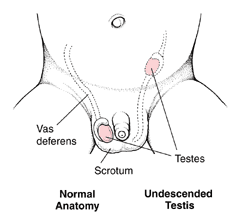
The testicles normally develop inside the abdominal cavity before birth. They descend into the scrotal sac by the 7th to 9th month of fetal development for optimal sperm production. Failure to do so before birth leads to the condition known as undescended testes or cryptorchidism. It can be in one side only or it can be bilateral. The most common cause is prematurity although this condition is also seen in 3% of full-term male infants. Other causes include hormonal disorders, genetics, and spina bifida. No symptoms are associated with this condition. It is usually discovered during routine medical history and physical examination. The undescended testis is expected to descend without any intervention by the 6th month of age. If by this time it still has not descended then it may not descend at all.Something has to be done to avoid complications later on. One of these complications which is the most common especially if the condition is bilateral is infertility. There is also risk of developing testicular cancer when the child reaches adulthood. The most bothersome effect to the growing child is the psychological aspect of having an empty scrotum. Pharmacotherapy involves hormonal injections of HCG (human chorionic gonadotrophin) given for several weeks. This hormone is expected to stimulate testosterone production leading to the descend of the testis to the scrotal sac. Unfortunately this type of management is often not successful.When this happens surgical approach is recommended. Orchiopexy is the surgical method of bringing down the testis into the scrotum. This procedure is done preferably between the 6th to 18th month of age. The earlier it is accomplished the better to prevent damage to the germ cells. Sometimes the testis can be felt inside the scrotum but sometimes it is not. This condition is different from the undescended testis that we are discussing. This is due to the cremasteric reflex that contraction of the muscle causes retraction of the testicle. It is called retractile testes. |
Better known as Ol' Johnny One Nut